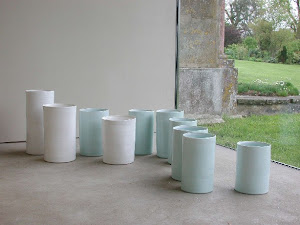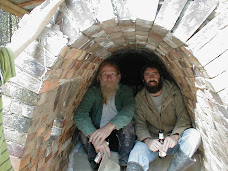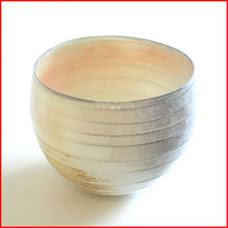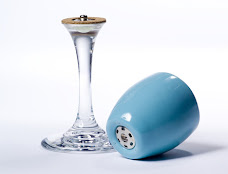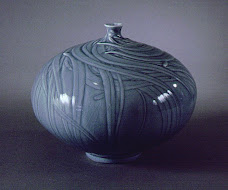Class:
- a social stratum sharing basic economic, political, or cultural characteristics, and having the same social position: Artisans form a distinct class in some societies.
-the system of dividing society; caste.
-social rank, esp. high rank.
-the members of a given group in society, regarded as a single entity.
Most people who are born onto any class stay within that class for life. Since I was born into a “middle class family, I will likely be middle class, unless I win the lottery or marry a very wealthy woman. (Both of which may happen at any moment.) The work that I do with clay/ceramics is tied to my history as a baker and a cook. It is also very much influenced by my having been raised in the country. I appreciate simple rustic things, and that is what I strive to create. These objects I make are meant to be in someone’s home or kitchen. I can imagine them living in a mansion, or castle, but they would likely be more at home in a small house or cottage. My work is made intentionally for any specific class. Since most of my friends and family are in the lower-middle class, this is where it ends up. I do not have any objection to people who create things for the upper class; it is just not what I do.
Then there is the polar opposite:
NEW YORK (AP) -- A sculpture of a stainless steel heart hanging from a golden bow sold Wednesday for $23.6 million, becoming the most expensive piece by a living artist ever auctioned, according to Sotheby's spokeswoman Lauren Gioia.
The bright magenta "Hanging Heart" sculpture is considered one of Jeff Koons' most important works.
The previous record for a living artist was Damien Hirst's "Lullaby Spring," which sold for $19.5 million at Sotheby's in London in June. Hirst's piece was a stainless steel cabinet containing 6,136 handcrafted and painted pills.
The Koons work was bought by the Gagosian Gallery, which had picked up his "Diamond [Blue]" sculpture for $11.8 million at a Christie's auction on Tuesday.
"Hanging Heart," nearly 9 feet tall and weighing more than 3,500 pounds, is from Koons' "Celebration" series, inspired by celebratory milestones such as birthdays and anniversaries. The "Diamond [Blue]" also is from the series.
"Koons is an artist who doesn't allow compromise, and 'Hanging Heart' is all about making an impossibility possible," said Tobias Meyer, head of Sotheby's contemporary art department.
The sculpture was offered for sale by a private American collector and had a pre-sale estimate of $15 million to $20 million. Its sale price included an auction house commission.
Friday, December 14, 2007
Wednesday, December 5, 2007
de Waal
Edmund de Waal - Ceramic Artist 1964-
Edmund de Waal was born in Nottingham, England in 1964. (4) He is considered to be one of the leading British potters of his generation. He has worked as a curator, a professor, a linguist and a lecturer. His studies and writings have made him an art critic and an art historian. Openings and spaces are continually studied and reinterpreted in his work. Edmund was raised in a clerical family, who attended church regularly. They lived near a few gothic cathedrals, and visited them and this is where Edmund was originally attracted to small spaces within larger architecture. When he was five, he asked for his father to take him to an evening class to learn how to make pots, and to throw. A small white pot, which he made, was the first pot he remembers liking. (2) From this age Edmund was already more attracted to minimalist work, than he was to busy, highly decorated objects.
Edmund then went to secondary school at the King’s School in Canterbury. There Geoffrey Whiting, who was one of the disciples of Bernard Leach, taught him pottery. (5) Whiting worked and taught very much in the Leach tradition, which brought together the East and the West by combining techniques and philosophies from Japan/China, and mediaeval English ceramics. Geoffrey Whiting believed very much in functional ceramics, and he taught Edmund in class and as his apprentice. By repetitively making pots, as a functional potter would, Edmund became more attuned to the slight differences in form. Edmund stated in an interview on BBC radio “… it’s a bit like doing scales as well – you’d never be surprised by a musician spending five years doing arpeggios, and there is a sense in a ceramic apprenticeship that that’s really what you’re doing.”
After Edmund graduated from secondary school he was sure that he wanted to become a potter. He continued as an apprentice for a couple years, and he undertook postgraduate studies in Japanese at Sheffield University. (4) He was awarded a Daiwa Anglo-Japanese Scholarship and worked at the Mejiro Ceramics Studio in Tokyo. He was brought up in a family of readers and writers, and though Edmund was immersed in ceramics he never stopped reading and writing. He then decided to attend Cambridge University, where he would study English. (2) Edmund is well known for his work with clay, but he is as well known for his writings. His books, which have been published, are:
Edmund de Waal Photography by Helene Binet Essays by Jorunn Veiteberg and Helen Waters Kettle's Yard / mima 2007
Rethinking Bernard Leach: Studio Pottery and Contemporary Ceramics (Japanese Edition) Shibunkaku Publishing Co. 2007
Twentieth Century Ceramics, Thames and Hudson, 2003
Design Sourcebook: Ceramics, New Holland Publishers, 1999 Dutch, German, American editions 1999 UK paperback edition 2003
Bernard Leach, Tate Publishing, 1998 new edition 1999, new edition 2003 Japanese edition 2006 with additional chapters
While Edmund studied English he continued to visit museums and galleries, such as the famous Kettle’s Yard. It was in these buildings that he began considering how his work could help re-design an interior space. Edmund was still dedicated to the idea that he would someday be a rural potter, and follow the Leach tradition. This meant that he would make “appropriate” work, which meant that he would make inexpensive domestic pottery with earth-like colors. In Geoffrey Whiting’s words, “Cheap enough to drop, part of everyone’s everyday life”, and this was Edmund’s mission statement. (2)
After finishing his studies at Cambridge University he set up a pottery studio in the countryside, on the Welsh borders, and then in Sheffield. Edmund was making functional stoneware vessels, and was still a potter who was very much influenced by the ideas and pots of Bernard Leach. Being aware of the “Anglo-Oriental” roots in his own work, he did not aspire to only continue the tradition. He had other influences, such as the work of early modernists and the Bauhaus movement. He had realized that he could critique the the Leach tradition intellectually while he was in Cambridge, and he began to do so. Leach was a very prolific writer, and potter as well. Bernard Leach wrote much of what Edmund had read about pottery and the union of the East and West. Edmund went back to Japan, and during this time he studied the local folk-craft, and the papers and journals of Leach. He noticed that Leach had actually not understood the language of Japanese, and that he only looked at certain forms. Edmund was finding “holes” in the studies, philosophies and writings of Leach. He decided to write about his findings, and this did not go over very well. Edmund found that the Leach tradition closes down opportunities for different kinds of work within ceramics. He found that
“...the great myth of Leach is that Leach is the great interlocutor for Japan and the East, the person who understood the East, who explained it to us all, brought out the mystery of the East. But in fact the people he was spending time with, and talking to, were very few, highly educated, often Western educated Japanese people, who in themselves had no particular contact with rural, unlettered Japan of peasant craftsman.” (2) These findings, and his writings gained him much criticism, as young Edmund had grown up within the Leach tradition.
Edmund de Waal’s current work has moved away from single objects, and is more concerned with openings and spaces. He now works solely in high-fire porcelain, with celadon glazes. He believes that it is porcelain that is the matrix for the East and West, the Sung Dynasty and the Bauhaus. (1) Though there is much history to these colors and materials his work has an undeniable contemporary look and feel. By making large numbers of classic cylindrical and circular shapes, and using clean celadon glazes, Edmund’s work is very recognizable. This work has gained much international recognition. He has won the following awards:
2003 Silver Medal, World Ceramics Exposition, Korea
2000-2002 Leverhulme Special Research Fellowship
1998 British Council Award
1996 London Arts Board Individual Artists Award
1996 Fellow of Royal Society of Arts
1991-1993 Daiwa Anglo-Japanese Foundation Scholarship
1985 Trinity Hall, Cambridge Scholarship
Edmund’s style has been labeled the height of minimalist chic, but his work speaks about more than just the forms and glazes. He experiments with how objects change a particular space, how they communicate with each other, and how much you even need to see of a pot for it to have an impact upon its surroundings. When asked if he felt his exploration of ceramics had become narrow with his choice of one type of clay and one type of glaze, he responded, “ I don’t think it’s narrow in the slightest. I think you can find breadth wherever you are.” (2) Edmund currently works and lives in London, where he shares a studio with Julian Stair, and his studio manager Marie Torbensdatter Hermann. He teaches at the University of Wesminster. His current artists statement is as follows:
I love the ‘visible imperfections’ that come from the gestures of throwing and handling clay and the fierce symmetries of industrial porcelain, the vessels of the chemical laboratory. My pots span both these histories. Working in Japan has given me a feeling for how pots can work in the hand, how their heft, balance and texture matters. So my pots are slightly bashed, slightly crooked and tell of their making.
For the last eight years I have also been making installation groups. I called them ‘cargoes’ of pots, an image that came from the images of sunken cargoes of porcelain.
There are few images of groups of porcelain – we are much more used to seeing single pieces in isolated splendour – and this has haunted me. Some of these installations were for Modernist houses as with my work at High Cross House in 1999. Some were for austere art galleries – as with the Porcelain Room made for the Geffrye Museum, 2002-2003 and shown at the Kunstindustri Museum in Copenhagen in 2004. For my solo show at Roche Court in 2004 I made three installations that respond to the Arcadian landscape in which the gallery sits. This focus on installation has allowed me to be ambitious in making pots that challenge architectural space. My installation groups focus on the ways in which subtle modulations are manifested through repetition.
Recent projects at Blackwell, the Lake District mansion designed by Baillie Scott and at the National Museum and Gallery, Wales have extended this practice.
Much of my recent work explores colour through hidden interstices and openings. These pieces look at how colour change through shadow.
All these pots were made in porcelain as I believe that it is the porcelain that is the matrix for East and West, the sung dynasty and the Bauhaus.
It remains to be a powerfully contemporary medium.
Bibliography
(1) Twentieth Century Ceramics, Thames and Hudson, 2003
(2) www.bbc.co.uk/radio3/johntusainterview/dewaal_transcript.shtml-69k-
(3) www.edmunddewaal.com
(4) collection.britishcouncil.org/html/artist.aspx?id=18077-13k
(5) Ceramics: Art and Perception, No. 54. 2003
Edmund de Waal was born in Nottingham, England in 1964. (4) He is considered to be one of the leading British potters of his generation. He has worked as a curator, a professor, a linguist and a lecturer. His studies and writings have made him an art critic and an art historian. Openings and spaces are continually studied and reinterpreted in his work. Edmund was raised in a clerical family, who attended church regularly. They lived near a few gothic cathedrals, and visited them and this is where Edmund was originally attracted to small spaces within larger architecture. When he was five, he asked for his father to take him to an evening class to learn how to make pots, and to throw. A small white pot, which he made, was the first pot he remembers liking. (2) From this age Edmund was already more attracted to minimalist work, than he was to busy, highly decorated objects.
Edmund then went to secondary school at the King’s School in Canterbury. There Geoffrey Whiting, who was one of the disciples of Bernard Leach, taught him pottery. (5) Whiting worked and taught very much in the Leach tradition, which brought together the East and the West by combining techniques and philosophies from Japan/China, and mediaeval English ceramics. Geoffrey Whiting believed very much in functional ceramics, and he taught Edmund in class and as his apprentice. By repetitively making pots, as a functional potter would, Edmund became more attuned to the slight differences in form. Edmund stated in an interview on BBC radio “… it’s a bit like doing scales as well – you’d never be surprised by a musician spending five years doing arpeggios, and there is a sense in a ceramic apprenticeship that that’s really what you’re doing.”
After Edmund graduated from secondary school he was sure that he wanted to become a potter. He continued as an apprentice for a couple years, and he undertook postgraduate studies in Japanese at Sheffield University. (4) He was awarded a Daiwa Anglo-Japanese Scholarship and worked at the Mejiro Ceramics Studio in Tokyo. He was brought up in a family of readers and writers, and though Edmund was immersed in ceramics he never stopped reading and writing. He then decided to attend Cambridge University, where he would study English. (2) Edmund is well known for his work with clay, but he is as well known for his writings. His books, which have been published, are:
Edmund de Waal Photography by Helene Binet Essays by Jorunn Veiteberg and Helen Waters Kettle's Yard / mima 2007
Rethinking Bernard Leach: Studio Pottery and Contemporary Ceramics (Japanese Edition) Shibunkaku Publishing Co. 2007
Twentieth Century Ceramics, Thames and Hudson, 2003
Design Sourcebook: Ceramics, New Holland Publishers, 1999 Dutch, German, American editions 1999 UK paperback edition 2003
Bernard Leach, Tate Publishing, 1998 new edition 1999, new edition 2003 Japanese edition 2006 with additional chapters
While Edmund studied English he continued to visit museums and galleries, such as the famous Kettle’s Yard. It was in these buildings that he began considering how his work could help re-design an interior space. Edmund was still dedicated to the idea that he would someday be a rural potter, and follow the Leach tradition. This meant that he would make “appropriate” work, which meant that he would make inexpensive domestic pottery with earth-like colors. In Geoffrey Whiting’s words, “Cheap enough to drop, part of everyone’s everyday life”, and this was Edmund’s mission statement. (2)
After finishing his studies at Cambridge University he set up a pottery studio in the countryside, on the Welsh borders, and then in Sheffield. Edmund was making functional stoneware vessels, and was still a potter who was very much influenced by the ideas and pots of Bernard Leach. Being aware of the “Anglo-Oriental” roots in his own work, he did not aspire to only continue the tradition. He had other influences, such as the work of early modernists and the Bauhaus movement. He had realized that he could critique the the Leach tradition intellectually while he was in Cambridge, and he began to do so. Leach was a very prolific writer, and potter as well. Bernard Leach wrote much of what Edmund had read about pottery and the union of the East and West. Edmund went back to Japan, and during this time he studied the local folk-craft, and the papers and journals of Leach. He noticed that Leach had actually not understood the language of Japanese, and that he only looked at certain forms. Edmund was finding “holes” in the studies, philosophies and writings of Leach. He decided to write about his findings, and this did not go over very well. Edmund found that the Leach tradition closes down opportunities for different kinds of work within ceramics. He found that
“...the great myth of Leach is that Leach is the great interlocutor for Japan and the East, the person who understood the East, who explained it to us all, brought out the mystery of the East. But in fact the people he was spending time with, and talking to, were very few, highly educated, often Western educated Japanese people, who in themselves had no particular contact with rural, unlettered Japan of peasant craftsman.” (2) These findings, and his writings gained him much criticism, as young Edmund had grown up within the Leach tradition.
Edmund de Waal’s current work has moved away from single objects, and is more concerned with openings and spaces. He now works solely in high-fire porcelain, with celadon glazes. He believes that it is porcelain that is the matrix for the East and West, the Sung Dynasty and the Bauhaus. (1) Though there is much history to these colors and materials his work has an undeniable contemporary look and feel. By making large numbers of classic cylindrical and circular shapes, and using clean celadon glazes, Edmund’s work is very recognizable. This work has gained much international recognition. He has won the following awards:
2003 Silver Medal, World Ceramics Exposition, Korea
2000-2002 Leverhulme Special Research Fellowship
1998 British Council Award
1996 London Arts Board Individual Artists Award
1996 Fellow of Royal Society of Arts
1991-1993 Daiwa Anglo-Japanese Foundation Scholarship
1985 Trinity Hall, Cambridge Scholarship
Edmund’s style has been labeled the height of minimalist chic, but his work speaks about more than just the forms and glazes. He experiments with how objects change a particular space, how they communicate with each other, and how much you even need to see of a pot for it to have an impact upon its surroundings. When asked if he felt his exploration of ceramics had become narrow with his choice of one type of clay and one type of glaze, he responded, “ I don’t think it’s narrow in the slightest. I think you can find breadth wherever you are.” (2) Edmund currently works and lives in London, where he shares a studio with Julian Stair, and his studio manager Marie Torbensdatter Hermann. He teaches at the University of Wesminster. His current artists statement is as follows:
I love the ‘visible imperfections’ that come from the gestures of throwing and handling clay and the fierce symmetries of industrial porcelain, the vessels of the chemical laboratory. My pots span both these histories. Working in Japan has given me a feeling for how pots can work in the hand, how their heft, balance and texture matters. So my pots are slightly bashed, slightly crooked and tell of their making.
For the last eight years I have also been making installation groups. I called them ‘cargoes’ of pots, an image that came from the images of sunken cargoes of porcelain.
There are few images of groups of porcelain – we are much more used to seeing single pieces in isolated splendour – and this has haunted me. Some of these installations were for Modernist houses as with my work at High Cross House in 1999. Some were for austere art galleries – as with the Porcelain Room made for the Geffrye Museum, 2002-2003 and shown at the Kunstindustri Museum in Copenhagen in 2004. For my solo show at Roche Court in 2004 I made three installations that respond to the Arcadian landscape in which the gallery sits. This focus on installation has allowed me to be ambitious in making pots that challenge architectural space. My installation groups focus on the ways in which subtle modulations are manifested through repetition.
Recent projects at Blackwell, the Lake District mansion designed by Baillie Scott and at the National Museum and Gallery, Wales have extended this practice.
Much of my recent work explores colour through hidden interstices and openings. These pieces look at how colour change through shadow.
All these pots were made in porcelain as I believe that it is the porcelain that is the matrix for East and West, the sung dynasty and the Bauhaus.
It remains to be a powerfully contemporary medium.
Bibliography
(1) Twentieth Century Ceramics, Thames and Hudson, 2003
(2) www.bbc.co.uk/radio3/johntusainterview/dewaal_transcript.shtml-69k-
(3) www.edmunddewaal.com
(4) collection.britishcouncil.org/html/artist.aspx?id=18077-13k
(5) Ceramics: Art and Perception, No. 54. 2003
Tuesday, December 4, 2007
ocarina
oc·a·ri·na (ŏk'ə-rē'nə)
n. A small terra-cotta or plastic wind instrument with finger holes, a mouthpiece, and an elongated ovoid shape.
[Italian, from dialectal ucarenna, diminutive of Italian oca, goose (from the fact that its mouthpiece is shaped like a goose's beak), from Vulgar Latin *auca, from *avica, from Latin avis, bird; see awi- in Indo-European roots.]
Decorated with figures in ceremonial dress and various animal effigies, clay ocarinas were a standard part of ceremonial life in pre-Columbian Central America. Made with a varying number of tone holes and in different sizes, ocarinas could imitate the calls of small birds as well as the resonant hoots of owls. Photo by Roger Hamilton—IDB.
The object I chose to look at in more detail was a small Pre-Columbian ceramic whistle. This was made in Peru, and was made inland, though it is in the shape of a shell. It is about 2” / 3” wide, and it was burnished and slip decorated. Like other Pre-Columbian vessels, it is unglazed and probably pit-fired. The animist culture in which this was made had great respect for the natural world, and this is apparent in their vessels for ceremony as well as those for everyday use. Respect for the ocean, as a metaphor for life, as a great source of food and weather, is apparent in their decorations and choice of forms. These simple forms, mimicking seashells, have a peaceful feeling to them. I am not sure exactly what they were used for, but they are said to have precise tones, possibly for specific people, times of the year, or for specific ceremonies. These were surely made after people had made similar whistles out of real shells. The people further from the ocean probably had a harder time getting objects from the ocean, but this did not hinder their desire to have such objects, they just made them out of clay. They also made many other sea forms, of other shells, fish, shellfish, and mammals. It is not hard for me to imagine a culture that was connected to nature in a way that our culture is not. Pre-Columbus, and Pre-Christ humans were generally more connected to the earth and its other inhabitants. People also thought of things cyclically, as the seasons cycle through time, as apposed to a more linear view of the world that was created primarily through Christianity. There are contemporary equivalents to such objects, but I have never seen or heard of them being used ceremonially today. The Pre-Columbian objects are worth quite a lot today, as they are “artifacts” from a past culture. I would love to have a small Pre-Columbian object. I had an attraction to these wares/objects long before I began working with clay myself. The relationship to the human body is obvious, it was made to be picked up and blown through.
n. A small terra-cotta or plastic wind instrument with finger holes, a mouthpiece, and an elongated ovoid shape.
[Italian, from dialectal ucarenna, diminutive of Italian oca, goose (from the fact that its mouthpiece is shaped like a goose's beak), from Vulgar Latin *auca, from *avica, from Latin avis, bird; see awi- in Indo-European roots.]
Decorated with figures in ceremonial dress and various animal effigies, clay ocarinas were a standard part of ceremonial life in pre-Columbian Central America. Made with a varying number of tone holes and in different sizes, ocarinas could imitate the calls of small birds as well as the resonant hoots of owls. Photo by Roger Hamilton—IDB.
The object I chose to look at in more detail was a small Pre-Columbian ceramic whistle. This was made in Peru, and was made inland, though it is in the shape of a shell. It is about 2” / 3” wide, and it was burnished and slip decorated. Like other Pre-Columbian vessels, it is unglazed and probably pit-fired. The animist culture in which this was made had great respect for the natural world, and this is apparent in their vessels for ceremony as well as those for everyday use. Respect for the ocean, as a metaphor for life, as a great source of food and weather, is apparent in their decorations and choice of forms. These simple forms, mimicking seashells, have a peaceful feeling to them. I am not sure exactly what they were used for, but they are said to have precise tones, possibly for specific people, times of the year, or for specific ceremonies. These were surely made after people had made similar whistles out of real shells. The people further from the ocean probably had a harder time getting objects from the ocean, but this did not hinder their desire to have such objects, they just made them out of clay. They also made many other sea forms, of other shells, fish, shellfish, and mammals. It is not hard for me to imagine a culture that was connected to nature in a way that our culture is not. Pre-Columbus, and Pre-Christ humans were generally more connected to the earth and its other inhabitants. People also thought of things cyclically, as the seasons cycle through time, as apposed to a more linear view of the world that was created primarily through Christianity. There are contemporary equivalents to such objects, but I have never seen or heard of them being used ceremonially today. The Pre-Columbian objects are worth quite a lot today, as they are “artifacts” from a past culture. I would love to have a small Pre-Columbian object. I had an attraction to these wares/objects long before I began working with clay myself. The relationship to the human body is obvious, it was made to be picked up and blown through.
Subscribe to:
Posts (Atom)
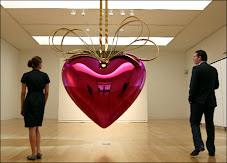.jpg)
